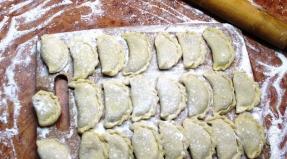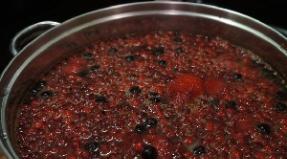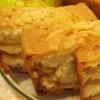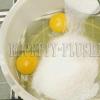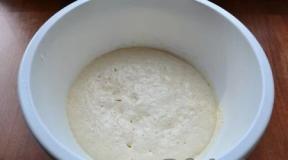Imeretian cheese: the taste of Western Georgia. Imeretian cheese Imeretian cheese made from goat milk
Imeretian cheese is a fresh Georgian cheese with a mild taste, which can be eaten the next day after preparation. In the Caucasus, freshly made Imeretian cheese is called the first cheese or young cheese. Khachapuri is baked with it and snacks are made, mixed with fresh herbs and spices. And also Imeretian cheese is a preparation for the famous suluguni cheese, which has remarkable melting properties.
INGREDIENTS:
- Milk - 6 l;
- (dosage according to instructions);
- starter culture (dosage according to instructions) or or
- - 0.6 g (for pasteurized milk);
- salt.
INVENTORY AND EQUIPMENT:
- Pot;
- .
RECIPE:
1. Heat homemade pasteurized milk to 32-33 ° C, stirring slowly so that it warms evenly.You can familiarize yourself with the technology of milk pasteurization at home . When the milk has warmed up, pour in it diluted in water . Sprinkle the starter culture powder on the surface of the milk, let stand and absorb moisture for 5 minutes, then mix thoroughly, distributing the starter throughout the milk. Cover the pot with a lid, wrap and let sit for 60 minutes to invigorate the culture and create the desired acidity level.
2. Stir the milk, then slowly pour in the enzyme diluted in 50 ml of purified water, stirring the milk constantly from top to bottom to distribute it as much as possible throughout the milk. Cover the saucepan with a lid and leave for 50-60 minutes to curd the milk.
3. Perform a clean compartment test. If the clot is not firm enough, leave it on for another 10-15 minutes. First, cut the curd up and down vertically. Cut interval 1 cm. Do not cut horizontally yet. Let the curd rest for 5 minutes and only then cut it into cubes with a side of 1 cm. The smaller the size of the cube, the less moisture will be in the resulting cheese.
4. After slicing, gently stir the curd for 10-20 minutes. While stirring the curd slowly, raise the temperature to 36-37 ° C for the next 10-15 minutes. When the temperature is reached, continue stirring the curd for another 10 minutes and then let it rest for 5 minutes to allow the curd to settle to the bottom of the pot.
5. Drain the whey so that it slightly covers the layer of curd (do not pour out the drained whey, it will be needed to prepare the brine).
6. Prepare the perforated form by covering it with gauze or , put in the sink. Gently pour the curd from the saucepan into the mold.
7. Place the cheese pan on the drain pan and let it self-press for half an hour. After half an hour, gently turn the cheese in the mold and rewrap it in dry, clean gauze or lavsan napkin and leave to press for another 1 hour.
8. While the cheese mass is being pressed, prepare an 18% whey brine: heat the whey (1l) to 80 ° С, dissolve the salt (250 g) in it, and then cool to 10 ° С in the refrigerator.
9. After an hour, gently turn the cheese in the mold and leave to press for another 1 hour.
11. Keep the container with the brine in the refrigerator. After salting, the cheese needs to be ripened in the same brine for another 12 hours, then remove it from the brine, blot excess moisture with a paper towel and place in a plastic container - the cheese is ready to eat.
All ingredients and equipment for making Imeretian cheese can be bought at .
Good luck with your homemade cheese making!
Today I propose to cook, in my opinion, the simplest, but nevertheless delicious Homemade Imeretian cheese.
Imeretian cheese is a fresh cheese of Georgian cuisine. It is with this cheese that real khachapuri are prepared. Preparing it at home is not at all difficult. I will cook this cheese in two versions: classic and with the addition of spices.
These are the products you need to make Imereti cheese at home. If the milk is pasteurized, then add calcium chloride to this. As additives, you can use your favorite spices or herbs. I have paprika and tomato flakes, as well as cumin.
Heat the milk to 38 degrees.

Add sourdough, it can be any fermented milk product, best of all homemade, I have homemade yogurt. Stir well and leave for 30 minutes.

Pour zira with a small amount of boiling water and leave to brew, so it will better reveal its aroma. Dissolve rennet in water with a temperature of 35 degrees. Let stand for 10-15 minutes.

After 30 minutes add the dissolved rennet to the milk. Stir thoroughly and leave for 40-60 minutes, until a dense curd forms. Check for "clean kink". To do this, lower your finger into the clot, it must remain absolutely clean.

Cut the curd into 2–3 cm cubes, leave for 10 minutes, until it sinks to the bottom.

Use your hands or a large slotted spoon to transfer the cheese mass to the cheese dish. Since I make two types, I put it in two forms, in one - pure cheese, and in the second - sprinkle with salt, strained zira and paprika flakes in the second. Press the mass with your hands a little for better whey discharge. Leave the cheese to self-press for 10-12 hours. During this time, you can turn the cheese in the molds once or twice.

I immediately sprinkled the cheese with spices with salt, but the simple cheese is not salted yet. For him, dissolve salt in water and put cheese in it, keep in brine at the rate of 1 hour per 500 grams of cheese. I got a 400 gram head, I kept it in brine for 1 hour.

Here is such a wonderful Imeretian cheese we get at home. I will also make a reservation that this cheese is recommended to be kept in a weak saline solution with the addition of sugar for several months, but I did not do that, we like it fresh.

Suluguni is also made from such cheese, letting it lie in the refrigerator for 3 days. Someday I'll show you how to do it too. I cooked this cheese to order, so there is no cut, but I will show a cut of exactly the same cheese that was cooked three days ago - holes appear in it from aging.

So making homemade Imeretian cheese is not at all difficult, I will be glad if the recipe is useful to someone.
Known far beyond the Caucasus Mountains. Many of her dishes are familiar not only to gourmets - at least once in their life, everyone tasted them, and even more so, heard the names. Lobio, satsivi, khinkali, chakhokhbili, khachapuri, kharcho are very popular. This is not a complete list of wonderful dishes of Georgian cuisine.
However, the beautiful mountainous country is known not only for the first and second courses, but also for excellent intoxicating drinks, which are traditionally accompanied by various types of cheese. The delicious taste of golden sparkling wine and the mild pungency of the national dairy product are timeless classics of gourmet cuisine.
Originally from Imereti
Among the many varieties of national cheese, Imeretian is the most famous. It owes its name to the region of the same name in Western Georgia. The area here is very beautiful: around the mountains, coniferous forests, many turbulent rivers and foamy waterfalls.
If you are lucky enough to visit Imereti, then you should definitely see the local sights - ancient fortresses, monasteries, Christian churches, national parks. Tasting of local wines should be a must on the program, the best of which are krahuna and tsolikauri. Such wonderful drinks are invariably served with a real brand of Western Georgia - Imeretian cheese.

Cheese making traditions
The history of cheese production in this Caucasian republic goes back more than one century. In the "House of Cheese", which is located in Tbilisi, a tableware is demonstrated in which this tasty and healthy food product was stored eight thousand (!) Years ago, while in other countries cheese began to be produced only four millennia later. Therefore, Georgia can rightfully be called the homeland of cheese.

In the highlands of the country, women of the older generation still use ancient recipes for making cheese. For example, some of its varieties are kept in honey, chacha, and covered with grapes. After the revived recipes began to be widely used in production, they found admirers among the modern inhabitants of Georgia.
According to official data, 14 varieties of cheese have now been recorded in the country: chogi, kalti, tenili, kobi, dambal khacho, meskhuri chechili, Georgian, Adjarian chechili, guda, Imeretian, suluguni, Tushinsky guda, Megrelian suluguni, Svan suluguni. By the way, all these varieties can be tasted in Tbilisi's "House of Cheese", where you can also learn about the history of their origin and see the objects with the help of which cheese was produced earlier, and in some mountain villages even now.
Favorite - suluguni and Imeretian cheese
The most famous are the Imeretian and suluguni cheeses. These varieties are so loved in Georgia that they are produced not only in special factories, but also at home. Moreover, along with the well-deserved popularity, these two varieties are interconnected for another reason: suluguni is made from Imeretian cheese, for this they use heat treatment and kneading the cheese mass in the same way as dough. As a result of all these actions, a brine with a layered structure is obtained, which Georgians love very much.
If suddenly the Russians have a question: "I have not found Imeretian cheese. How can I replace it?" - then the answer will be obvious: suluguni. You can also try to cook it yourself. How? And this is what we will tell you now!
Imeretian cheese: recipe
For its production, unboiled fresh milk is used, so all the useful minerals and vitamins are preserved in the final product.
It is not difficult to make Imeretian cheese at home. Its recipe includes:
- fresh cow's milk - 1 liter;
- pepsin - 60 ml;
- cold water - 1 liter;
- table salt - 1 tablespoon;
- granulated sugar - 1 tablespoon.
Further actions:
- The milk should be warmed up to a temperature of 38 ºС and filtered into an enamel pan. Then add pepsin, stir with a spoon and leave in a warm place.
- After half an hour, the milk ferments, then the resulting cheese mass must be separated from the whey.
- The resulting base should be placed in a special form with holes or a colander, and a pallet should be placed under it. The surface of the future cheese must be leveled and salted with coarse salt.
- In order for the Imeretian cheese to mature, it must be placed in a special solution - tsatkhi. To do this, water is poured into a glass container, salt and sugar are added, and then cheese is placed. Everything is sealed with a lid and left in a warm place. In four days, homemade Imeretian cheese will be ready.

About benefits and not only
First of all, the usefulness of this type of cheese will be appreciated by people watching their figure - its calorie content is only 240 kilocalories. One hundred grams of Imeretian cheese contains 18.5 grams of protein, 14 grams of fat, and 2.4 grams of carbohydrates.
This product, made from milk, can be eaten by Georgians at any time of the day - for breakfast, lunch and dinner, with aromatic cakes, bread, a bite with tea, and is used in the preparation of salads and soups.
On this occasion, even a saying arose, which says that only the one who died does not have cheese. In small Georgia, about 80 thousand tons of cheese are produced annually.
Imeretian cheese dishes
The popular Imeretian cheese is used not only as an excellent appetizer for wine, but also as one of the ingredients in various dishes. For example, Imeretian khachapuri, khychins, penovani, various salads are very tasty.

Penovani is a type of baked khachapuri, which is made from puff pastry, and the product we are considering is preferable as a filling.
Khychiny - a pie with boiled potatoes mixed with suluguni and Imeretian cheese. The peculiarity of this dish is that it is fried in a dry pan.
Khachapuri - baked yeast cakes stuffed with suluguni and Imeretian cheese.
For 1 liter of brine:
- 1 liter of water
- 1 tbsp. l. salt
- 1 tbsp. l. Sahara
STEP-BY-STEP COOKING RECIPE
Strain milk (steam or heated to 37.5–38 ° С) through sterile gauze into an earthenware or enamel dish, add pepsin to it, stir with a wooden spoon clockwise, place near a heat source. Turn the dishes from time to time so that the milk ferments evenly.
After 25-30 minutes, when the milk is fermented, with clean hands, collect the cheese mass into one lump and separate it from the whey.
Place the tender cheese mass in a mold - it is convenient to use a cylindrical colander with a flat bottom, in which the cheese will take the right shape. Place a colander on a drip tray to drain the liquid. Smooth the surface of the cheese with your hands and sprinkle it with coarse salt.
After 2-3 days, ready-made young cheese can be used to make suluguni. If you need to bring it to maturity, prepare "tsatkhi", that is, a special pickle for storing cheese. Mix water, salt and sugar, pour into an enamel or glass dish, add cheese and cover. It is advisable to put in a warm place - so that the cheese forms holes, for 3-4 days.
Only on your own experience can you learn all the intricacies of cheese making. According to popular belief, pepsin in milk should be stirred exclusively with an unplanned fig branch! Do not pour the whey after the cheese in any case - put it on low heat for 2-3 hours, then strain through a fine colander: this is how nadugi is done (in Georgian - "boiled for a long time or many times"
